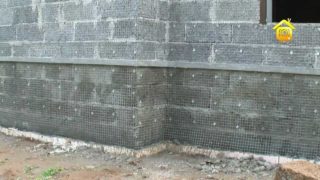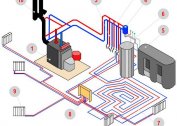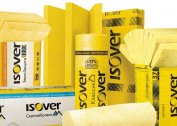Effective thermal insulation of building structures is one of the prerequisites for maintaining a comfortable climate in residential buildings. Many technologies are known that involve the use of a wide variety of insulation materials for these purposes. It is possible to successfully cope with this task if high-tech substances with a high thermal insulation rate are used. One such material is arbolite.
Operational characteristics
Serial production of arbolite blocks is based on the use of a special binder - Portland cement grade M400 or M500. In addition, the mixture contains wood filler (wood chips or sawdust), the proportion of which reaches 90 percent. To mineralize it, a little calcium or aluminum sulfate is added to the prepared solution.
These substances accelerate the hardening of cement-wood mortar. Thus, almost 90 percent of the obtained insulation material is chopped wood. Therefore, arbolite blocks in their thermal insulation indicators are more reminiscent of wood than concrete.
Advantages and disadvantages

The advantages of insulation material of this class include:
- low thermal conductivity, which allows saving on the used building material;
- high strength indicators;
- good soundproof characteristics;
- light weight and ease of installation;
- environmental friendliness.
According to its strength characteristics, this insulation resembles building blocks based on foam and gaseous substances. Due to its constituent wood, arbolite is more plastic. With significant loads, it does not crack, but only deforms, which is an indisputable advantage when compared with other materials.
Among the shortcomings of insulation of this class are noted:
- the impossibility of equipping them with a powerful reinforcing belt and floors;
- flammability - with prolonged contact with fire, it is charred and deformed;
- high level of hygroscopicity - the material absorbs up to 80 percent moisture by volume.
The water that accumulates in the pores during the winter season freezes, after which the blocks are deformed and fall apart.
Materials and equipment for manufacturing
To make do-it-yourself wood concrete, you will need the following equipment and supplies:
- a device for cutting raw wood (chip cutter);
- silos for chips and cement;
- containers for loading chemicals and water;
- molds for pouring liquid composition;
- drying chamber;
- wood billets;
- chemicals and binders;
The listed components and equipment are enough to engage in the production of do-it-yourself arbolite blocks in significant quantities.
Block manufacturing technology
Independent manufacture of wood concrete slabs according to the technological plan begins with chopping raw wood chips, after which it is allowed to lie down mixed with chemical reagents. Wood chips are chopped in their raw form, which makes it possible to give it the desired shape, and then provide the ability to remove wood juices. The production of arbolite is strictly standardized, as a result of which one cubic meter of obtained raw materials will require:
- 8-10 kg of chemicals;
- 250 kg of cement;
- 250 kg of raw wood chips.
When mixing, the chips are wetted so that moisture is not released, and the raw material itself is covered with a layer of cement connecting the fragments to each other. The subsequent tampering will make it possible to clog the pores of the molded blocks, which gives the finished structure the desired density.
Chemical Compliance
In correctly manufactured blocks, the ratio of components is set very accurately and cannot be very different from the norm. This mainly concerns cement and chemical additives that determine the quality of the resulting composition. For this purpose, sugar is washed out of wood by mixing with the following reagents:
- aluminum sulfate;
- calcium chloride;
- sodium silicate (its other name is “liquid glass”);
- slaked lime.
As a result of treatment with reagents, the pores of the wood are filled with these compounds, eliminating the possibility of absorption of water.
Organic components
The function of the organic filler, in addition to wood chips, is often performed by plant structures, the grinding of which produces needle-shaped fragments. In this capacity are often used:
- pruning branches;
- tree branches;
- branches with leaves.
To maintain the required proportions for the manufacture of wood concrete at home, straw, hay and sawdust are often used, which are added in the required quantities.
Manufacturing conditions
In the manufacture of blocks, the solution is poured into pre-prepared forms manually using a shovel and a conventional bucket. The rammer for the filled mixture is made of a suitable size timber and is used only when filling the container with a composition with a small slide. Do not ram the solution after the formation of each successive layer. This method of laying allows you to get a homogeneous mixture of high quality.
Ramming is not yet fully completed for arbolit forms is unacceptable, as this leads to delimitation of layers and poor grasp. After completion of the operations, the prepared mixture is allowed to settle in the mold for 2-3 days. Next, the formwork is dismantled, the finished blocks are laid out in the open air for drying. If you have free funds, you can purchase expensive vibration equipment that allows you to compact the material directly in the molds.
The purpose of the arbolite blocks
Depending on the area of use at construction sites, arbolite insulation blocks are divided into two types - heat-insulating and structural modules. According to the accepted classification, the defining feature is the density indicator of the material. When constructing the load-bearing walls of buildings, for example, the use of blocks with a density below 500 kilograms per cubic meter is not allowed. Samples with lower values are only suitable for thermal insulation of external walls in houses with load-bearing structures that take the load from the elements of the floors and roof.
Structural material of this class is used in private construction in the construction of low-rise buildings. In addition, a wide range of block blanks of various shapes and sizes is made from it. In some countries, arbolite blocks are used in the construction of industrial facilities and multi-storey residential buildings. A number of manufacturers make on their basis foundations for small structures like garages or utility buildings. In addition, arbolite mixture is often used to warm frame buildings and fill the walls of wooden or reinforced concrete wells.








